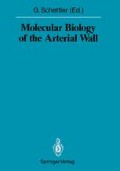Abstract
Recent studies have indicated that the liver is the principal organ for the catabolism of lipoproteins. The liver is however not a homogeneous tissue (Van Berkel 1982) and consists of parenchymal cells (contributing 92.5% to total liver protein), endothelial cells (contributing 3.3%), Kupffer cells (2.5%) and fat-storing cells (1.7%). The present research is focussed upon a determination of the relative importance of the various cell types in exerting the integral liver function. Procedures were developed to isolate from one liver all the various cell types (Van Berkel et al. 1985). A cell isolation procedure performed at a low temperature (at 8° C) allows a quantitative determination of the in vivo uptake of radio-labelled ligand because during cell isolation no degradation or release of cell-associated radioactivity occurs (Nagelkerke et al. 1983). Furthermore, receptors are preserved during cell isolation enabling in vitro studies on receptor specificity and receptor-dependent processing of lipoproteins.
Access this chapter
Tax calculation will be finalised at checkout
Purchases are for personal use only
References
Brown MS, Basu SK, Falck JR, Ho YK, Goldstein JL (1980) J Supramol Struct 13: 67–81
Harkes L, Van Berkel ThJC (1984a) Biochem J 224: 21–27
Harkes L, Van Berkel ThJC (1984b) Biochim Biophys Acta 794: 340–347
Harkes L, Van Duyne A, Van Berkel ThJC (1987) submitted for publication
Nagelkerke JF, Barto KP, Van Berkel ThJC (1983) J Biol Chem 258: 12221–12227
Nagelkerke JF, Van Berkel ThJC (1986) Biochim Biophys Acta 875: 593–598
Nagelkerke JF, Bakkeren HF, Kuiper F, Vonk RJ, Van Berkel ThJC (1986) J Biol Chem 261: 8908–8913
Van Berkel ThJC (1982) in Metabolic Compartmentation ( Sies H, ed) Academic Press Inc, London, pp 437–482
Van Berkel ThJC, Nagelkerke JF, Harkes L, Kruijt JK (1982) Biochem J 208: 493–503
Van Berkel ThJC, Kruijt JK, Nagelkerke JF, Harkes L (1985) in Receptor-Mediated Uptake in the Liver (Greten, Windler, Beisiegel, eds) Springer Verlag, Berlin, pp 33–37
Author information
Authors and Affiliations
Editor information
Editors and Affiliations
Rights and permissions
Copyright information
© 1987 Springer-Verlag Berlin Heidelberg
About this paper
Cite this paper
van Berkel, T.J.C., Harkes, L., Nagelkerke, J.F., Kruijt, J.K. (1987). Lipoprotein disposition by the liver: A concerted action of various cell types. In: Schettler, G. (eds) Molecular Biology of the Arterial Wall. Veröffentlichungen aus der Geomedizinischen Forschungsstelle der Heidelberger Akademie der Wissenschaften, vol 1987/88 / 1987/4. Springer, Berlin, Heidelberg. https://doi.org/10.1007/978-3-642-83118-8_6
Download citation
DOI: https://doi.org/10.1007/978-3-642-83118-8_6
Publisher Name: Springer, Berlin, Heidelberg
Print ISBN: 978-3-540-17899-6
Online ISBN: 978-3-642-83118-8
eBook Packages: Springer Book Archive

